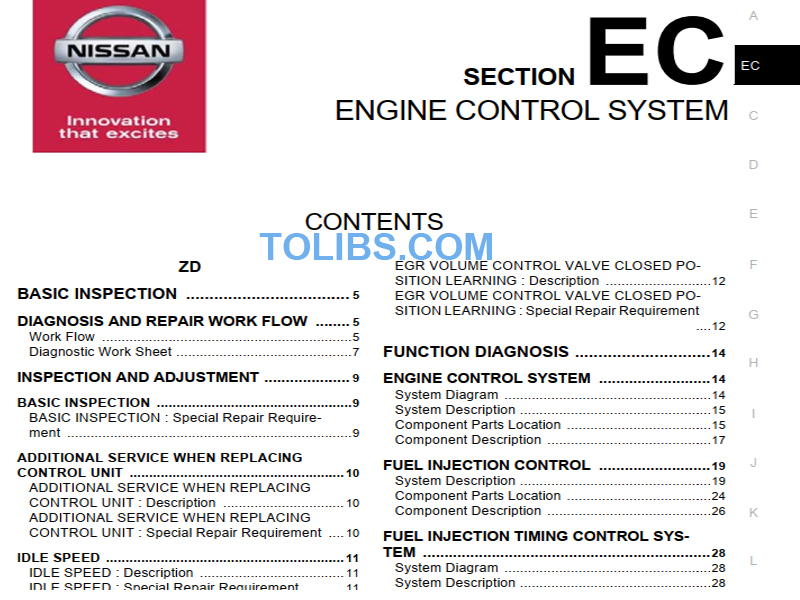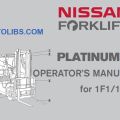Nissan Cabstar Engine Workshop Manual

DIAGNOSIS RK FLOW
GET INFORMATION FOR SYMPTOM
Get the detailed information from the customer about the symptom (the condition and the environment when the incident/malfunction occurred) using the “Diagnostic Work Sheet”.
CHECK DTC
- Check DTC.
- Perform the following procedure if DTC is displayed.
- Record DTC and freeze frame data. (Print them out with CONSULT-III or GST.)
- Study the relationship between the cause detected by DTC and the symptom described by the customer. (Symptom Matrix Chart is useful. Refer to EC-240, "Symptom Table".)
- 3. Check related service bulletins for information.
Is any symptom described and is any DTC detected?
- Symptom is described, DTC is detected: GO TO 3.
- Symptom is described, DTC is not detected: GO TO 4.
- Symptom is not described, DTC is detected: GO TO 5.
CONFIRM THE SYMPTOM
Try to confirm the symptom described by the customer (except MI ON). Also study the normal operation related to the symptom. Refer to EC-243, "Description". Diagnostic Work Sheet is useful to verify the incident. Verify relation between the symptom and the condition when the symptom is detected.
Try to confirm the symptom described by the customer. Also study the normal operation related to the symptom. Refer to EC-243, "Description". Diagnostic Work Sheet is useful to verify the incident. Verify relation between the symptom and the condition when the symptom is detected.
DETECT MALFUNCTIONING PART BY DIAGNOSIS PROCEDURE
Inspect according to Diagnosis Procedure of the system. NOTE:The Diagnosis Procedure in EC section described based on open circuit inspection. A short circuit inspection is also required for the circuit check in the Diagnosis Procedure. For details, refer to GI-22, "How to Perform Efficient Diagnosis for an Electrical Incident".
Is malfunctioning part detected?
- YES: GO TO 10.
- NO: Monitor input data from related sensors or check voltage of related ECM terminals using CONSULT-III. Refer to EC-226, "Reference Value".
REPAIR OR REPLACE THE MALFUNCTIONING PART
Repair or replace the malfunctioning part. Another DTC may be detected if parts or connectors are disconnected during the inspection. After repair and replacement, reconnect parts or connectors that are disconnected during the inspection. If DTC is displayed, perform DTC Confirmation Procedure for the applicable DTC, and then erase it.
FINAL CHECK
Erase DTC after performing DTC Confirmation Procedure for the applicable DTC, or perform Component Function Check and check that the repair is complete. When symptom is described from the customer, refer to confirmed symptom in step 3 or 4, and check that the symptom is not detected.
Is DTC detected and does symptom remain?
- YES-1: DTC is detected: GO TO 9.
- YES-2: Symptom remains: GO TO 7.
- NO: Before returning the vehicle to the customer, check that DTC is erased.
Diagnostic Work Sheet
There are many operating conditions that lead to the malfunction of engine components. A good grasp of such conditions can make troubleshooting faster and more accurate. In general, each customer feels differently about a incident. It is important to fully understand the symptoms or conditions for a customer complaint. Utilize a diagnostic worksheet like the one on the next page in order to organize all the information for troubleshooting. Some conditions may cause the MI to come on steady and DTC to be detected.
BASIC INSPECTION : Special Repair Requirement
INSPECTION START
- Check service records for any recent repairs that may indicate a related incident.
- Check the current need for scheduled maintenance, especially for fuel filter and air cleaner filter. Refer to MA-6, "Periodic Maintenance".
- Open engine hood and check the following:
- Harness connectors for improper connections
- Vacuum hoses for splits, kinks, or improper connections
- Wiring for improper connections, pinches, or cuts
- Confirm that electrical or mechanical loads are not applied.
- Headlamp switch is OFF.
- Air conditioner switch is OFF.
- Steering wheel is in the straight-ahead position, etc.
- Start engine and warm it up to the normal operating temperature.
INJECTOR ADJUSTMENT VALUE REGISTRATION
Injector adjustment value (1) indicates manufacturing tolerance and the value is printed on the top of fuel injector. (Example: C1TGMA) The injector adjustment value which is correctly stored in ECM is needed for precise fuel injection control.
A performance of emission control and a drivability may effect when there is a mismatch between the following two values.
- The injector adjustment value stored in ECM
- The injector adjustment value of the injector which is installed on the vehicle Injector adjustment value registration must be performed after the following cases.
- Fuel injector(s) are replaced. In this case, injector adjustment value registration for the replaced fuel injector must be performed.
- ECM is replaced. In this case, injector adjustment value registration for all the fuel injectors must be performed.
EGR VOLUME CONTROL VALVE CLOSED POSITION LEARNING
EGR Volume Control Valve Closed Position Learning is an operation to learn the fully closed position of the EGR volume control valve by monitoring the EGR volume control valve control position sensor output signal. It must be performed under any of the following conditions:
- EGR volume control valve is removed.
- EGR volume control valve is replaced.
- ECM is replaced.
Update Nissan Atlas F24 (1.15-2t) Catalog document












